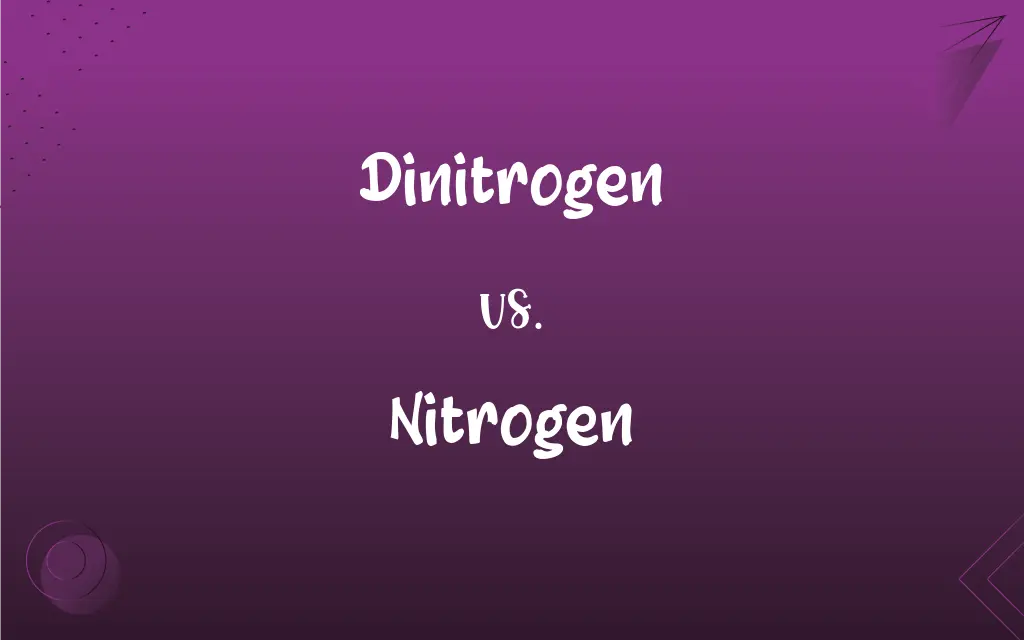Dinitrogen vs. Nitrogen: What's the Difference?
Edited by Janet White || By Harlon Moss || Updated on November 9, 2023
Dinitrogen is the diatomic molecule N2, the most common form of nitrogen in the Earth's atmosphere; nitrogen refers to the chemical element with atomic number 7.

Key Differences
In chemistry, dinitrogen is often used to describe the gaseous form of the element that is used in industrial processes, such as the Haber process for producing ammonia. Nitrogen, as an element, can bond with other elements to form a vast array of compounds, from nitric acid to organic molecules like amino acids.
While dinitrogen is relatively non-reactive due to the triple bond holding the two nitrogen atoms together, nitrogen atoms in other compounds can be highly reactive. For example, nitrogen in ammonia (NH3) can form bonds with acids to create ammonium salts.
Dinitrogen's stability makes it a significant part of the Earth's atmosphere, where it plays a role in buffering changes in the atmosphere and is involved in processes such as the nitrogen cycle. Nitrogen in other forms is essential for life, as it is a key component of amino acids, which are the building blocks of proteins.
The isolation of nitrogen in its pure form from dinitrogen in the atmosphere was a significant achievement in chemistry. Nitrogen in its pure form is used in a variety of applications, including the creation of inert atmospheres for the preservation of food and the manufacture of electronics.
Comparison Chart
Definition
Molecular nitrogen with two atoms (N2)
The chemical element (N)
ADVERTISEMENT
Occurrence
Primarily in the Earth's atmosphere
Found in various compounds and the atmosphere
Reactivity
Inert and stable due to a triple bond
Varies; reactive in compounds like ammonia
Industrial Usage
Used in the Haber process, among others
Used in a variety of chemical processes
Biological Importance
Less direct biological role
Essential for life, found in amino acids, proteins, DNA
Dinitrogen and Nitrogen Definitions
Dinitrogen
The chemical form of nitrogen gas.
Dinitrogen is used in the synthesis of ammonia.
ADVERTISEMENT
Nitrogen
The most abundant element in the Earth's atmosphere.
Nitrogen gas is released during the denitrification process.
Dinitrogen
A stable homonuclear molecule.
Dinitrogen is inert and does not easily react at room temperature.
Nitrogen
A constituent of amino acids and nucleic acids.
Nitrogen bases pair up to form the rungs of the DNA ladder.
Dinitrogen
A colorless, odorless, and tasteless gas.
Dinitrogen fills up over 78% of the air we breathe.
Nitrogen
A chemical element with the symbol N and atomic number 7.
Nitrogen is essential for plant growth.
Dinitrogen
The molecular form of nitrogen.
Dinitrogen is fixed by bacteria in the soil to be used by plants.
Nitrogen
An essential nutrient for life.
Nitrogen fertilizers are added to enhance soil productivity.
Dinitrogen
A diatomic molecule consisting of two nitrogen atoms.
Dinitrogen is the most abundant gas in the atmosphere.
Nitrogen
A component of all proteins.
Nitrogen must be present in the soil for crops to flourish.
Dinitrogen
(chemistry) the normal nitrogen molecule having two atoms Category:en:Nitrogen
Nitrogen
A nonmetallic element that constitutes nearly four-fifths of the air by volume, occurring as a colorless, odorless, almost inert diatomic gas, N2, in various minerals and in all proteins and used in a wide variety of applications, including manufacture of ammonia, nitric acid, TNT, and fertilizers, and as a cryogen. Atomic number 7; atomic weight 14.0067; melting point -210.00°C; boiling point -195.80°C; valence 2, 3, 4, 5. See Periodic Table.
Dinitrogen
Two atoms of nitrogen as part of some other compound
Nitrogen
(uncountable) The chemical element (symbol N) with an atomic number of 7 and atomic weight of 14.0067. It is a colorless and odorless gas. Category:en:Nitrogen
Nitrogen
(uncountable) Molecular nitrogen (N2), a colorless, odorless gas at room temperature.
Nitrogen
(countable) A specific nitrogen atom within a chemical formula, or a specific isotope of nitrogen
The two nitrogens are located next to one another on the ring.
Nitrogen
A colorless nonmetallic element of atomic number 7, tasteless and odorless, comprising four fifths of the atmosphere by volume in the form of molecular nitrogen (N2). It is chemically very inert in the free state, and as such is incapable of supporting life (hence the name azote still used by French chemists); but it forms many important compounds, such as ammonia, nitric acid, the cyanides, etc, and is a constituent of all organized living tissues, animal or vegetable. Symbol N. Atomic weight 14.007. It was formerly regarded as a permanent noncondensible gas, but was liquefied in 1877 by Cailletet of Paris, and Pictet of Geneva, and boils at -195.8 ° C at atmospheric pressure. Liquid nitrogen is used as a refrigerant to store delicate materials, such as bacteria, cells, and other biological materials.
Nitrogen
A common nonmetallic element that is normally a colorless odorless tasteless inert diatomic gas; constitutes 78 percent of the atmosphere by volume; a constituent of all living tissues
FAQs
What is dinitrogen commonly referred to as?
Dinitrogen is commonly referred to as nitrogen gas.
Can dinitrogen be found in living organisms?
Yes, but indirectly; it must first be converted to other nitrogen-containing compounds.
What does the term nitrogen commonly represent?
It represents the chemical element in any form, including dinitrogen.
Is nitrogen important for life?
Yes, it's a key component of amino acids and DNA.
Is dinitrogen reactive?
No, dinitrogen is very stable and inert.
Can dinitrogen bond with other elements?
Not easily; it requires specific conditions or catalysts to react.
Is dinitrogen used in its pure form industrially?
Yes, particularly in processes requiring an inert atmosphere.
How is dinitrogen converted for biological use?
Through a process called nitrogen fixation, performed by certain bacteria.
Do dinitrogen and nitrogen refer to the same thing in science?
Not exactly; dinitrogen specifically refers to the N2 molecule, while nitrogen is the element in general.
Is nitrogen found alone in nature?
Rarely; it's usually found as dinitrogen or in compounds.
What is the main use of dinitrogen in industry?
As a raw material for the production of ammonia.
What form of nitrogen do plants use?
Plants use nitrogen in the form of nitrates and ammonium ions, not dinitrogen.
What is the bond like in a dinitrogen molecule?
It's a triple bond, which is very strong and stable.
Is dinitrogen harmful to humans?
Not under normal conditions, but it can displace oxygen and cause asphyxiation in confined spaces.
Are dinitrogen and nitrogen interchangeable in scientific terminology?
They can be, depending on the context, but it's more precise to use "dinitrogen" when referring to the N2 molecule.
What is the state of dinitrogen at room temperature?
It is a gas at room temperature.
Does nitrogen have any isotopes?
Yes, nitrogen has two stable isotopes: nitrogen-14 and nitrogen-15.
Is dinitrogen soluble in water?
Dinitrogen is poorly soluble in water.
How is nitrogen cycled in the environment?
Through the nitrogen cycle, involving processes like fixation, nitrification, and denitrification.
Can nitrogen form compounds with metals?
Yes, nitrogen forms a variety of compounds with metals, such as nitrides.
About Author
Written by
Harlon MossHarlon is a seasoned quality moderator and accomplished content writer for Difference Wiki. An alumnus of the prestigious University of California, he earned his degree in Computer Science. Leveraging his academic background, Harlon brings a meticulous and informed perspective to his work, ensuring content accuracy and excellence.
Edited by
Janet WhiteJanet White has been an esteemed writer and blogger for Difference Wiki. Holding a Master's degree in Science and Medical Journalism from the prestigious Boston University, she has consistently demonstrated her expertise and passion for her field. When she's not immersed in her work, Janet relishes her time exercising, delving into a good book, and cherishing moments with friends and family.






























































